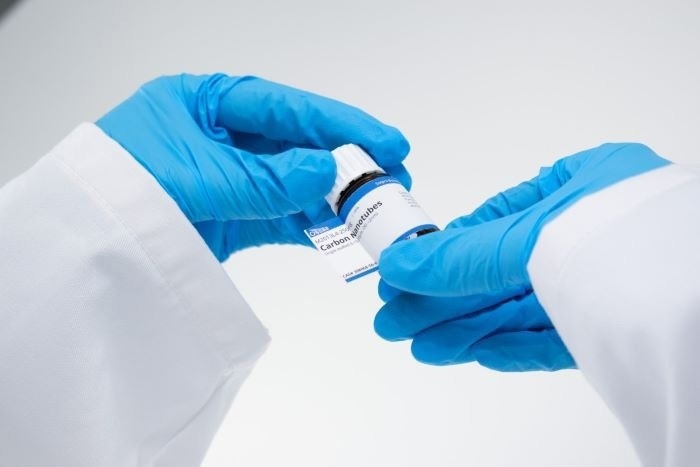Nanomaterials have become indispensable tools in biochemistry, providing innovative approaches to studying and manipulating biological systems at the molecular level. To fully utilize their potential, the synthesis of these materials must be carefully controlled.
For many nanomaterials, synthesis under inert conditions—where reactive gases like oxygen and water vapor are excluded—is crucial. This process ensures the preservation of their unique properties, such as chemical stability, high surface area, and biocompatibility, which are essential for their effective use in various biochemical applications.
Nanomaterials in Biochemistry
Enzyme Immobilization and Catalysis
Immobilizing enzymes on nanomaterials can enhance their stability, reusability, and catalytic efficiency. This process protects enzymes from denaturation and allows for their repeated use in applications like biosensing and industrial biocatalysis.
Gold nanoparticles provide an ideal platform for enzyme immobilization. When synthesized in inert conditions, they provide a clean, unoxidized surface that can be functionalized with thiol groups to covalently bind enzymes. The uniform size and shape, preserved during inert synthesis, ensures a consistent surface for enzyme attachment, improving catalytic performance.
Metabolomics and Biomolecule Profiling
Nanomaterials are also used in metabolomics, the comprehensive study of small molecules or metabolites in biological systems. Carbon nanotubes and metal oxides enhance the sensitivity and selectivity of analytical techniques like mass spectrometry and nuclear magnetic resonance spectroscopy.
Magnetic nanoparticles are particularly useful for pre-concentrating and purifying metabolites from complex biological samples before analysis. This pre-treatment significantly improves detection limits and the accuracy of metabolomic studies, making it easier to identify disease biomarkers and understand metabolic pathways.

Image Credit: Ossila Ltd
When synthesized under controlled conditions, these nanoparticles offer a stable and inert surface, minimizing interference and matrix effects. This results in more accurate metabolite profiling, contributing to deeper insights into biological processes.
Biosensing and Diagnostic Applications
Nanomaterials are crucial in developing biosensors that can detect biomolecules at extremely low concentrations. Quantum dots and metal nanoparticles are commonly used in these applications due to their unique optical properties, such as fluorescence and surface plasmon resonance. These biosensors offer high sensitivity and specificity in detecting biomolecules like proteins, nucleic acids, and metabolites, allowing for early disease diagnosis and real-time monitoring of biochemical processes.
Synthesizing nanoparticles in inert conditions is critical to preserving their optical properties. Exposure to oxygen can cause oxidation, which diminishes fluorescence or alters their optical properties. Quantum dots, synthesized in oxygen-free environments, maintain strong fluorescence intensity and photostability, making them ideal for fluorescence-based biosensors. Similarly, gold nanoparticles synthesized under inert conditions preserve their surface plasmon resonance, enabling their use in colorimetric assays for visually detecting target biomolecules.
Protein and Nucleic Acid Interactions
Understanding the interactions between proteins and nucleic acids is fundamental in biochemistry, with implications for drug discovery, disease research, and genetic studies. Magnetic nanoparticles, when functionalized with specific ligands, can capture and isolate target proteins or nucleic acids from complex biological samples. This technique is especially valuable for studying protein-DNA interactions, identifying transcription factors, and mapping gene regulatory networks.
Nanomaterials synthesized under inert conditions provide a stable and well-defined platform for studying these interactions. The inert synthesis of these nanoparticles ensures that their magnetic properties and surface chemistry are preserved, enabling efficient separation and analysis of biomolecular interactions.
By controlling the surface properties of nanoparticles, researchers can observe these interactions in real time, gaining crucial insights into molecular mechanisms that are key to cellular function and new therapeutic development.
The Importance of Inert Conditions in Synthesis
Nanomaterials exhibit remarkable properties due to their nanoscale dimensions, but their high reactivity makes them prone to degradation. Exposure to oxygen and moisture during synthesis can cause oxidation, unwanted reactions, and structural defects, significantly compromising their performance in biochemical applications.
Nanomaterials are often synthesized in inert environments, such as a glove box, to avoid these issues. This controlled atmosphere prevents reactions with the surrounding environment, ensuring the materials maintain their precise size, shape, chemical composition, and surface functionality—critical parameters for their success in biochemical applications.

Image Credit: Ossila Ltd
Challenges and Future Perspectives
Synthesizing nanomaterials under inert conditions presents significant challenges, especially when scaling up the process. The need for specialized equipment and strict environmental controls can make the process complex and expensive while achieving uniformity and reproducibility in large-scale production remains a technical obstacle.
However, ongoing research is focused on developing more efficient and cost-effective synthesis methods. Innovations like automated synthesis platforms and environmentally controlled reactors are being explored to streamline the process. As these technologies improve, we can expect to see broader adoption of nanomaterials synthesized under inert conditions in biochemistry, leading to new discoveries and innovations in the field.
Shaping Biochemistry with Nanomaterials
Nanomaterials synthesized under inert conditions are revolutionizing the field of biochemistry by providing stable, highly functional platforms for a wide range of applications. From enhancing enzyme catalysis and biosensing to facilitating biomolecular interactions and metabolomics study, these meticulously engineered materials open new frontiers in biochemical research.
As synthesis techniques continue to advance, the impact of these nanomaterials on biochemistry will only grow, driving forward our understanding of life at the molecular level and enabling new breakthroughs in science and medicine.

This information has been sourced, reviewed and adapted from materials provided by Ossila Ltd.
For more information on this source, please visit
Last Updated: Oct 15, 2024